User:T358wang: Difference between revisions
| Line 17: | Line 17: | ||
There are also three potential problems: | There are also three potential problems: | ||
'''1.''' The processed data set contains a little error content | '''1.''' The processed data set contains a little error content. The image content is not clean, and the quantity is huge. | ||
'''2.''' The algorithm for learning the training set must be fast and scalable. | '''2.''' The algorithm for learning the training set must be fast and scalable. | ||
Revision as of 13:19, 29 November 2020
Group
Rui Chen, Zeren Shen, Zihao Guo, Taohao Wang
Introduction
Landmark recognition is an image retrieval task with its own specific challenges. This paper provides a new and effective method to recognize landmark images, which has been successfully applied to actual images. In this way, statues, buildings, and characteristic objects can be effectively identified.
There are many difficulties encountered in the development process:
1. The concept of landmarks is not strictly defined. Landmarks can take various forms including objects and buildings.
2. The same landmark can be photographed from different angles. Certain angles may capture the interior of a building as opposed to its exterior. This could result in vastly different picture characteristics between angles. A good model should accurately identify landmarks regardless of perspective.
3. The dataset is unbalanced. The majority of objects fall into the single class of "not landmarks", while relatively few images exist for each class of landmark. Hence, it will be challenging to obtain both a low false positive rate as well as a high recognition accuracy between classes of landmarks.
There are also three potential problems:
1. The processed data set contains a little error content. The image content is not clean, and the quantity is huge.
2. The algorithm for learning the training set must be fast and scalable.
3. While displaying high-quality judgment landmarks, there is no image geographic information mixed.
The article describes the deep convolutional neural network (CNN) architecture, loss function, training method, and inference aspects. Using this model, similar metrics to the state of the art model in the test were obtained and the inference time was found to be 15 times faster. Further, because of the efficient architecture, the system can serve in an online fashion. The results of quantitative experiments will be displayed through testing and deployment effect analysis to prove the effectiveness of the model.
Related Work
Landmark recognition can be regarded as one of the tasks of image retrieval, and a large number of documents concentrate on image retrieval tasks. In the past two decades, the field of image retrieval has made significant progress, and the main methods can be divided into two categories. The first is a classic retrieval method using local features, a method based on local feature descriptors organized in bag-of-words(A bag of words model is defined as a simplified representation of the text information by retrieving only the significant words in a sentence or paragraph while disregarding its grammar. The bag of words approach is commonly used in classification tasks where the words are used as features in the model-training), spatial verification, Hamming embedding, and query expansion. These methods are dominant in image retrieval. Later, until the rise of deep convolutional neural networks (CNN), CNNs were used to generate global descriptors of input images.
Vector of Locally Aggregated Descriptors which uses first-order statistics of the local descriptor is one of the main representatives of local features-based methods. Another method is to selectively match the kernel Hamming embedding method extension. With the advent of deep convolutional neural networks, the most effective image retrieval method is based on training CNNs for specific tasks. Deep networks are very powerful for semantic feature representation, which allows us to effectively use them for landmark recognition. This method shows good results but brings additional memory and complexity costs. The DELF (DEep local feature) by Noh et al. proved promising results. This method combines the classic local feature method with deep learning. This allows us to extract local features from the input image and then use RANSAC for geometric verification. Random Sample Consensus (RANSAC) is a method to smooth data containing a significant percentage of errors, which is ideally suited for applications in automated image analysis where interpretation is based on the data generated by error-prone feature detectors. The goal of the project is to describe a method for accurate and fast large-scale landmark recognition using the advantages of deep convolutional neural networks.
Methodology
This section will describe in detail the CNN architecture, loss function, training procedure, and inference implementation of the landmark recognition system. The figure below is an overview of the landmark recognition system.

The landmark CNN consists of three parts: the main network, the embedding layer, and the classification layer. To obtain a CNN main network suitable for training landmark recognition model, fine-tuning is applied and several pre-trained backbones (Residual Networks) based on other similar datasets, including ResNet-50, ResNet-200, SE-ResNext-101, and Wide Residual Network (WRN-50-2), are evaluated based on inference quality and efficiency. Based on the evaluation results, WRN-50-2 is selected as the optimal backbone architecture. Fine-tuning is a very efficient technique in various computer vision applications because we can take advantage of everything the model has already learned and applied it to our specific task.
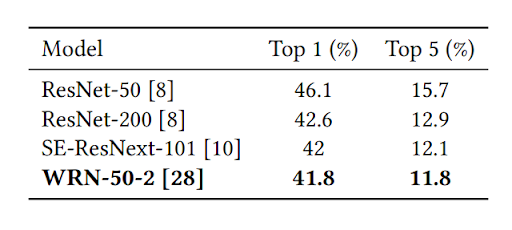
For the embedding layer, as shown in the below figure, the last fully-connected layer after the averaging pool is removed. Instead, a fully-connected 2048 [math]\displaystyle{ \times }[/math] 512 layer and a batch normalization are added as the embedding layer. After the batch norm, a fully-connected 512 [math]\displaystyle{ \times }[/math] n layer is added as the classification layer. The below figure shows the overview of the CNN architecture of the landmark recognition system.

To effectively determine the embedding vectors for each landmark class (centroids), the network needs to be trained to have the members of each class to be as close as possible to the centroids. Several suitable loss functions are evaluated including Contrastive Loss, Arcface, and Center loss. The center loss is selected since it achieves the optimal test results and it trains a center of embeddings of each class and penalizes distances between image embeddings as well as their class centers. In addition, the center loss is a simple addition to softmax loss and is trivial to implement.
When implementing the loss function, a new additional class that includes all non-landmark instances needs to be added and the center loss function needs to be modified as follows: Let n be the number of landmark classes, m be the mini-batch size, [math]\displaystyle{ x_i \in R^d }[/math] is the i-th embedding and [math]\displaystyle{ y_i }[/math] is the corresponding label where [math]\displaystyle{ y_i \in }[/math] {1,...,n,n+1}, n+1 is the label of the non-landmark class. Denote [math]\displaystyle{ W \in R^{d \times n} }[/math] as the weights of the classifier layer, [math]\displaystyle{ W_j }[/math] as its j-th column. Let [math]\displaystyle{ c_{y_i} }[/math] be the [math]\displaystyle{ y_i }[/math] th embeddings center from Center loss and [math]\displaystyle{ \lambda }[/math] be the balancing parameter of Center loss. Then the final loss function will be:

In the training procedure, the stochastic gradient descent(SGD) will be used as the optimizer with momentum=0.9 and weight decay = 5e-3. For the center loss function, the parameter [math]\displaystyle{ \lambda }[/math] is set to 5e-5. Each image is resized to 256 [math]\displaystyle{ \times }[/math] 256 and several data augmentations are applied to the dataset including random resized crop, color jitter, and random flip. The training dataset is divided into four parts based on the geographical affiliation of cities where landmarks are located: Europe/Russia, North America/Australia/Oceania, the Middle East/North Africa, and the Far East Regions.
The paper introduces curriculum learning for landmark recognition, which is shown in the below figure. The algorithm is trained for 30 epochs and the learning rate [math]\displaystyle{ \alpha_1, \alpha_2, \alpha_3 }[/math] will be reduced by a factor of 10 at the 12th epoch and 24th epoch.
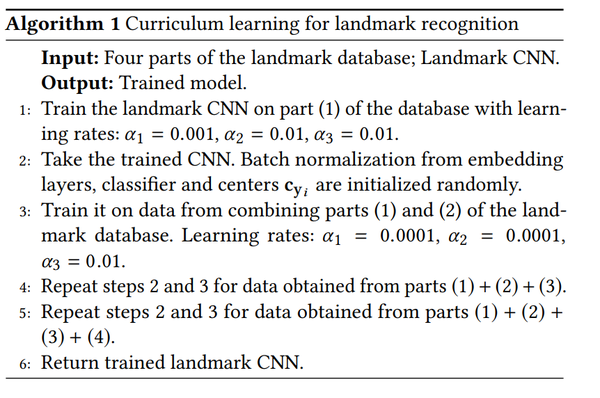
In the inference phase, the paper introduces the term “centroids” which are embedding vectors that are calculated by averaging embeddings and are used to describe landmark classes. The calculation of centroids is significant to effectively determine whether a query image contains a landmark. The paper proposes two approaches to help the inference algorithm to calculate the centroids. First, instead of using the entire training data for each landmark, data cleaning is done to remove most of the redundant and irrelevant elements in the image. For example, if the landmark we are interested in is a palace located on a city square, then images of a similar building on the same square are included in the data which can affect the centroids. Second, since each landmark can have different shooting angles, it is more efficient to calculate a separate centroid for each shooting angle. Hence, a hierarchical agglomerative clustering algorithm is proposed to partition training data into several valid clusters for each landmark and the set of centroids for a landmark L can be represented by [math]\displaystyle{ \mu_{l_j} = \frac{1}{|C_j|} \sum_{i \in C_j} x_i, j \in 1,...,v }[/math] where v is the number of valid clusters for landmark L and v=1 if there is no valid clusters for L.
Once the centroids are calculated for each landmark class, the system can make decisions whether there is any landmark in an image. The query image is passed through the landmark CNN and the resulting embedding vector is compared with all centroids by dot product similarity using approximate k-nearest neighbors (AKNN). To distinguish landmark classes from non-landmark, a threshold [math]\displaystyle{ \eta }[/math] is set and it will be compared with the maximum similarity to determine if the image contains any landmarks.
The full inference algorithm is described in the below figure.
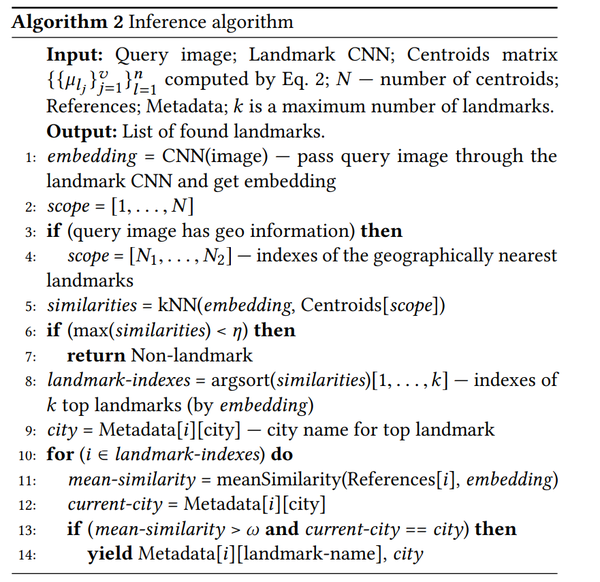
We will now look at how the landmark database was created. The collection process was structured by countries, cities and landmarks. They divided the world into several regions: Europe, America, Middle East, Africa, Far East, Australia and Oceania. Within each region, cities were selected that contained a lot of significant landmarks, and some natural landmarks were filtered out as they are difficult to distinguish. Once the cities and landmarks were selected, both images and metadata were collected for each landmark.
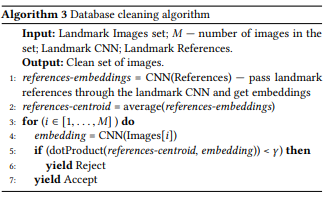
After forming the database, it had to be cleaned before it could be used to train the CNN. First, for each landmark, any redundant images were removed. Then for each landmark, 5 images were picked that had a high probability of containing the landmark and were checked manually. The database was then cleaned by parts using the curriculum learning process. It is further described in the pseudocode above. The final database contained 11381 landmarks in 503 cities and 70 countries. With 2331784 landmark images and 900000 non-landmark images. The number of landmarks that have less than 100 images is called "rare".
Experiments and Analysis
Offline test
In order to measure the quality of the model, an offline test set was collected and manually labeled. According to the calculations, photos containing landmarks make up 1 − 3% of the total number of photos on average. This distribution was emulated in an offline test, and the geo-information and landmark references weren’t used. The results of this test are presented in the table below. Two metrics were used to measure the results of experiments: Sensitivity — the accuracy of a model on images with landmarks (also called Recall) and Specificity — the accuracy of a model on images without landmarks. Several types of DELF were evaluated, and the best results in terms of sensitivity and specificity were included in the table below. The table also contains the results of the model trained only with Softmax loss, Softmax, and Center loss. Thus, the table below reflects improvements in our approach with the addition of new elements in it.
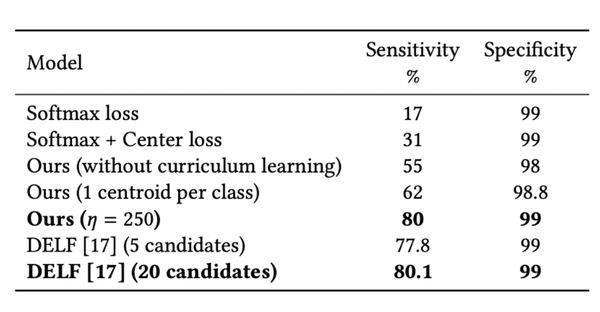
It’s very important to understand how a model works on “rare” landmarks due to the small amount of data for them. Therefore, the behavior of the model was examined separately on “rare” and “frequent” landmarks in the table below. The column “Part from total number” shows what percentage of landmark examples in the offline test has the corresponding type of landmarks. And we find that the sensitivity of “frequent” landmarks is much higher than “rare” landmarks.

Analysis of the behavior of the model in different categories of landmarks in the offline test is presented in the table below. These results show that the model can successfully work with various categories of landmarks. Predictably better results (92% of sensitivity and 99.5% of specificity) could also be obtained when the offline test with geo-information was launched on the model.
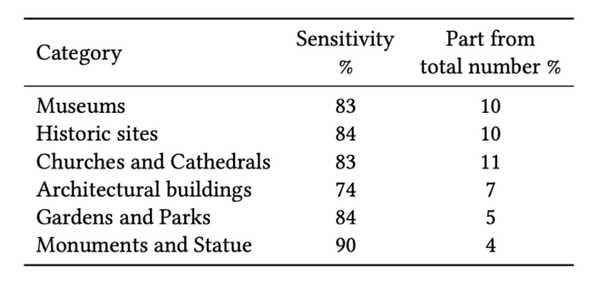
Revisited Paris dataset
Revisited Paris dataset (RPar)[2] was also used to measure the quality of the landmark recognition approach. This dataset with Revisited Oxford (ROxf) is standard benchmarks for the comparison of image retrieval algorithms. In recognition, it is important to determine the landmark, which is contained in the query image. Images of the same landmark can have different shooting angles or taken inside/outside the building. Thus, it is reasonable to measure the quality of the model in the standard and adapt it to the task settings. That means not all classes from queries are presented in the landmark dataset. For those images containing correct landmarks but taken from different shooting angles within the building, we transferred them to the “junk” category, which does not influence the final score and makes the test markup closer to our model’s goal. Results on RPar with and without distractors in medium and hard modes are presented in the table below.
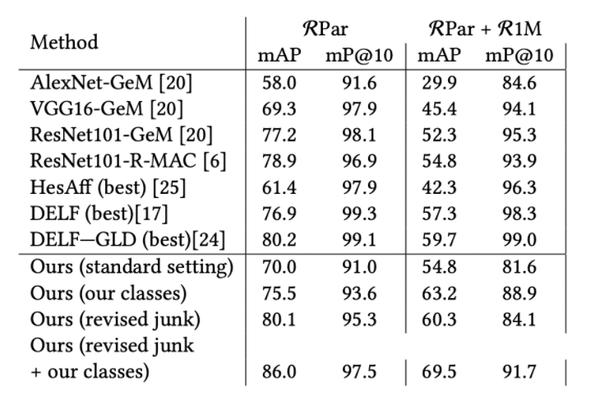
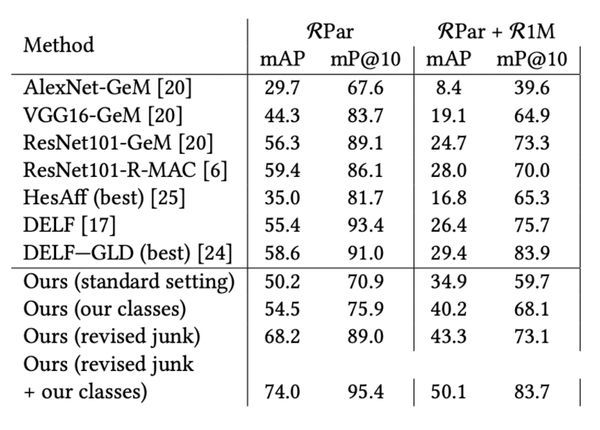
Comparison
Recent most efficient approaches to landmark recognition are built on fine-tuned CNN. We chose to compare our method to DELF on how well each performs on recognition tasks. A brief summary is given below:

Offline test and timing
Both approaches obtained similar results for image retrieval in the offline test (shown in the sensitivity&specificity table), but the proposed approach is much faster on the inference stage and more memory efficient.
To be more detailed, during the inference stage, DELF needs more forward passes through CNN, has to search the entire database, and performs the RANSAC method for geometric verification. All of them make it much more time-consuming than our proposed approach. Our approach mainly uses centroids, this makes it take less time and needs to store fewer elements.
Conclusion
In this paper we were hoping to solve some difficulties that emerge when trying to apply landmark recognition to the production level: there might not be a clean & sufficiently large database for interesting tasks, algorithms should be fast, scalable, and should aim for low FP and high accuracy.
While aiming for these goals, we presented a way of cleaning landmark data. And most importantly, we introduced the usage of embeddings of deep CNN to make recognition fast and scalable, trained by curriculum learning techniques with modified versions of Center loss. Compared to the state-of-the-art methods, this approach shows similar results but is much faster and suitable for implementation on a large scale.
Critique
The paper selected 5 images per landmark and checked them manually. That means the training process takes a long time on data cleaning and so the proposed algorithm lacks reusability. Also, since only the landmarks that are the largest and most popular were used to train the CNN, the trained model will probably be most useful in big cities instead of smaller cities with less popular landmarks.
In addition, researchers often look for reliability and reproducibility. By using a private database and manually labeling, it lends itself to an array of issues in terms of validity and integrity. Researchers who are looking for such an algorithm will not be able to sufficiently determine if the experiments do actually yield the claimed results. Also, manual labeling by those who are related to the individuals conducting this research also raises the question of conflict of interest. The primary experiment of this paper should be on public and third-party datasets.
It might be worth looking into the ability to generalize better, for example, can this model applied to other structures such as logos, symbols, etc. It would allow a different point of view of how the models perform well or not.
This is a very interesting implementation in some specific field. The paper shows a process to analyze the problem and trains the model based on deep CNN implementation. In future work, it would be some practical advice to compare the deep CNN model with other models. By comparison, we might receive a more comprehensive training model for landmark recognition.
This summary has a good structure and the methodology part is very clear for readers to understand. Using some diagrams for the comparison with other methods is good for visualization for readers. Since the dataset is marked manually, so it is kind of time-consuming for training a model. So it might be interesting to discuss how the famous IT company (i.e. Google etc.) fix this problem.
It would be beneficial if the authors could provide more explanations regarding the DELF method. Visualization of the differences between DELF and CNN from an algorithm and architecture perspective would be highly significant for the context of this paper.
One challenge of landmark recognition is the large number of classes. It would be good to see the comparison between the proposed model and other models in terms of efficiency.
The scope of this paper seems to work specifically with some of the most well known landmarks in the world, and many of these landmarks are well known because they are very distinct in how they look. It would be interesting to see how well the model works when classifying different landmarks of similar type (ie, Notre Dame Cathedral vs. St. Paul's Cathedral, etc.). It would also be interesting to see how this model compares with other models in literature, or if this is unique, perhaps the authors could scale this model down to a landmark classification problem (castles, churches, parks, etc.) and compare against other models that way.
Paper 25 (Loss Function Search in Facial Recognition) also utilizes the softmax loss function in feature discrimination in images. The difference between this paper and paper 25 is that this paper focuses on landmark images, whereas paper 25 is for facial recognition. Despite the slightly different application, both papers prove the importance of using the softmax loss function in feature discrimination, which is pretty neat.
The paper uses typical representatives of landmarks in various continents during training. It would be interesting to see how different results would be if the average structure of all landmarks present were used.
The curriculum learning algorithm categories the landmarks into four different geographical locations, i.e (1) Europe, (2) North America, Australia and Oceania; (3) Middle East, North Africa; (4) Far east, because landmarks from same geographical locations are similar to each other than from different geographical locations. Landmarks can also be categorized into archeological landmarks like medieval castles, architectural landmarks like monuments, biological landmarks like some parks or gardens, geological landmarks like caves etc, and it would be interesting to explore what kinds of results the curriculum learning algorithm would produce if the landmarks were categorized in different ways. Also In paper 17, i.e poker AI, uses an approach were similar decision points in the game were grouped together in a process called abstraction. Therefore a similar kind approach of grouping objects is used in the methods described in both papers which indeed helps in reducing the computational time and makes the process more scalable.
References
[1] Andrei Boiarov and Eduard Tyantov. 2019. Large Scale Landmark Recognition via Deep Metric Learning. In The 28th ACM International Conference on Information and Knowledge Management (CIKM ’19), November 3–7, 2019, Beijing, China. ACM, New York, NY, USA, 10 pages. https://arxiv.org/pdf/1908.10192.pdf 3357384.3357956
[2] FilipRadenović,AhmetIscen,GiorgosTolias,YannisAvrithis,andOndřejChum. 2018. Revisiting Oxford and Paris: Large-Scale Image Retrieval Benchmarking. arXiv preprint arXiv:1803.11285 (2018).